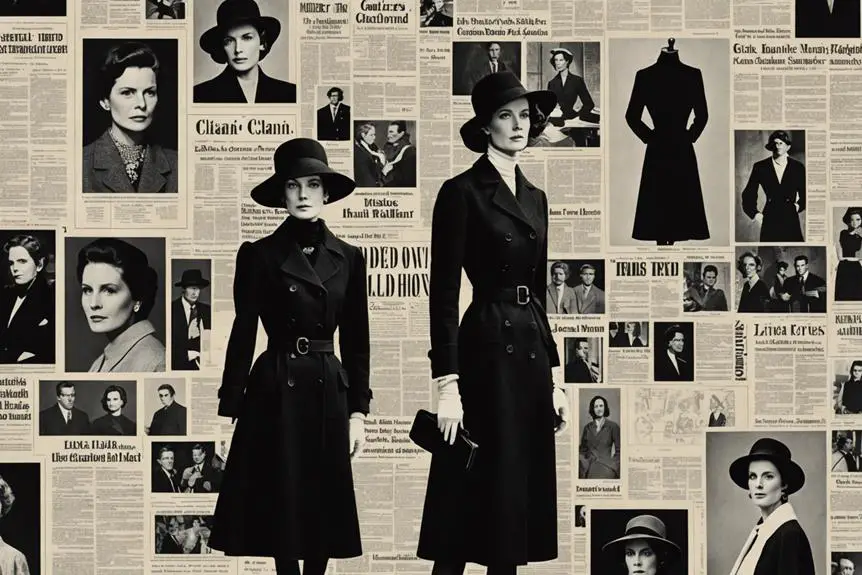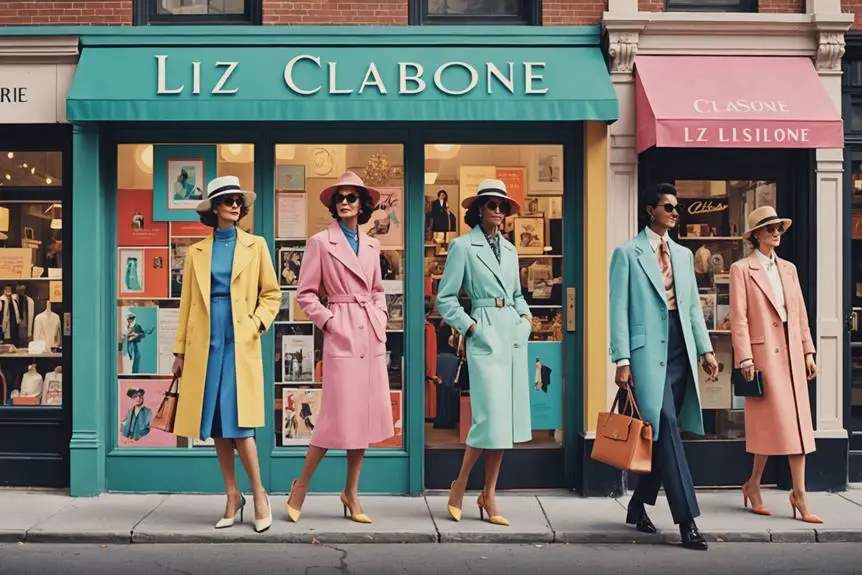Liz Claiborne Inc. has a remarkable history that traces back to its founder's roots in Brussels in 1929. After relocating to New York, Liz Claiborne developed her design skills and established her namesake brand in 1976. The label quickly rose to prominence, specializing in stylish, ready-to-wear clothing tailored for the modern working woman. By the late 1990s, Liz Claiborne Inc. experienced tremendous success, achieving over $2 billion in revenue.
However, the brand faced its share of challenges, including public relations hurdles and financial setbacks. Despite these obstacles, Liz Claiborne's legacy endures, marked by her philanthropic efforts and her induction into various fashion industry halls of fame. The story of Liz Claiborne Inc. is not only about fashion but also about the significant impact it has had on the industry and the ongoing evolution of the brand itself.
Early Life and Education

Liz Claiborne's journey into the world of fashion began long before she became a household name, rooted in her early life and education. Born in Brussels on March 31, 1929, to American parents, she faced a significant change when her family moved to New Orleans in 1939 due to World War II. This shift exposed her to a diverse cultural landscape that would later inform her design sensibilities.
Claiborne's educational path included attending St. Timothy's School for Girls in Maryland and Mountain Lakes High School in New Jersey, but she didn't complete her formal schooling. Instead, she opted for a more hands-on approach, pursuing art studies across Europe. Her parents played an essential role in shaping her artistic inclinations, as they encouraged her early exposure to art and sewing.
Informally studying at institutions like the Fine Arts School in Belgium and the Nice Academy in France, Liz honed her skills. This dedication culminated in 1949 when she won the Jacques Heim National Design Contest at just 21, a victory that would propel her to New York City and set the stage for her illustrious career in fashion design.
Career Beginnings
Starting her career in fashion after winning the Jacques Heim National Design Contest in 1949 set Claiborne on a path to reshaping women's clothing. At just 20, she moved to New York City, immersing herself in the vibrant fashion scene. Claiborne gained invaluable experience as a sketch artist and model for designer Tina Leser, later stepping into the role of design assistant for Omar Kiam. These early roles sharpened her skills and provided insight into the industry's inner workings.
Throughout the 1950s, she focused on designing sportswear, dresses, and tailored clothing, becoming the main designer for Jonathan Logan's junior dress division from 1960 to 1975. This period allowed her to observe firsthand the needs of working women, which would later influence her career trajectory. Balancing her professional aspirations with family life, Claiborne raised children from two marriages, all while feeling frustrated by the lack of practical clothing options for women in the workforce. These frustrations ultimately inspired her to launch Liz Claiborne Inc. in 1976, targeting this demographic with stylish, ready-to-wear professional clothes, thereby marking a pivotal moment in her career beginnings and the fashion industry.
Founding Liz Claiborne, Inc

Frustration over the lack of stylish, practical clothing for working women fueled the desire to create a brand that would address these needs directly. In 1976, Liz Claiborne, Inc. was founded by Liz Claiborne alongside partners Art Ortenberg, Leonard Boxer, and Jerome Chazen, with an initial investment of $250,000. This innovative company targeted working women by offering ready-to-wear clothing that emphasized quality, comfort, and moderate pricing.
In its first year, Liz Claiborne, Inc. achieved remarkable sales exceeding $2 million, a proof of the brand's immediate appeal. By 1978, sales soared to $28 million. The brand revolutionized department store layouts, creating dedicated sections exclusively for Liz Claiborne products, which enhanced visibility and accessibility.
Here's a quick overview of Liz Claiborne, Inc.'s early achievements:
| Year | Achievement |
|---|---|
| 1976 | Founded by Liz Claiborne and partners |
| 1977 | First-year sales exceeded $2 million |
| 1978 | Sales grew to $28 million |
| 1981 | Went public |
| 1986 | First female-led company on Fortune 500 |
This pioneering approach greatly impacted women's fashion and business leadership.
Growth and Market Position
In just a few short years, Liz Claiborne, Inc. rapidly established itself as a formidable player in the fashion industry, with sales climbing from over $2 million in its inaugural year to an impressive $117 million by 1981. This remarkable growth laid the groundwork for the company's public offering that same year, enhancing its market position. The brand's pioneering approach in creating designated spaces in department stores transformed the shopping experience for consumers. By 1986, Liz Claiborne became the first female-led company on the Fortune 500 list, a notable milestone underscoring its impact.
- Revenues peaked at over $2 billion in the late 1990s.
- The brand captured one-third of the American women's upscale sportswear market by 1988.
- Innovative marketing strategies distinguished Liz Claiborne from competitors.
- The company's ability to adapt to changing consumer preferences fueled its growth.
- Despite challenges in the 2000s, its legacy influences the fashion industry today.
Liz Claiborne's commitment to understanding the American women's sportswear market allowed the company to thrive. Its innovative marketing not only resonated with consumers but also set a benchmark for future brands, solidifying Liz Claiborne's enduring influence in women's fashion. For those interested in vintage items, recognizing the evolution of vintage tags and logos can notably enhance appreciation for the brand's rich history.
Challenges and Controversies

The challenges and controversies surrounding Liz Claiborne, Inc. reveal the complexities of steering public perception in the ever-evolving fashion landscape. A significant moment occurred in 1992 when a false rumor claimed Liz Claiborne didn't design for black women, largely propagated by influential figures like Spike Lee. This misconception severely impacted the brand's public relations efforts.
In 2006, the decision to produce clothing exclusively for J.C. Penney sparked backlash from Macy's, leading to a sharp decline in earnings. By Q1 2007, the company faced a 65% drop in earnings, marking its first loss in the millennium. Cumulative net losses exceeded $2 billion over five years, highlighting operational inefficiencies and management issues.
As Liz Claiborne was acquired by Fifth & Pacific Companies in 2011, it struggled to maintain market relevance amid fierce competition and shifting consumer preferences. The table below summarizes the brand's financial struggles and controversies:
| Year | Financial Impact | Key Controversy |
|---|---|---|
| 1992 | Brand Damage | False Rumor |
| 2006 | Declining Sales | Retail Backlash |
| 2007 | 65% Earnings Drop | Losses Reported |
| 2011 | $2B Losses | Acquisition Issues |
Legacy and Honors
Despite the challenges faced by Liz Claiborne, Inc. and the controversies that marred its reputation, Liz Claiborne's legacy endures through her remarkable contributions to the fashion industry. Her impact stretches beyond just clothing; it encompasses entrepreneurship and social responsibility. You can see the depth of her influence reflected in numerous honors she received throughout her career:
- Lifetime Achievement Award from the Council of Fashion Designers of America in 2000.
- Honorary Doctorate of Fine Arts from the Rhode Island School of Design, recognizing her design impact.
- Induction into the National Business Hall of Fame in 1990 for pioneering female entrepreneurship.
- Election to the National Sales Hall of Fame in 1991, marking her transformative role in women's apparel.
- Establishment of the Liz Claiborne and Art Ortenberg Foundation, highlighting her commitment to philanthropy and environmental causes.
These accolades not only celebrate her achievements but also underscore her role as a trailblazer in the fashion industry. Liz Claiborne's legacy continues to inspire future generations, proving that fashion can merge with social consciousness.
Frequently Asked Questions
What Is the History of Liz Claiborne Company?
To understand the history of Liz Claiborne, you'll see how it transformed women's fashion in the late 20th century, pioneering ready-to-wear designs and achieving remarkable sales milestones before facing challenges in a changing retail landscape.
What Are Some Interesting Facts About Liz Claiborne?
You'll find Liz Claiborne was a pioneer in lifestyle branding, achieving $2 million in sales within her first year. She became the first woman-led company on the Fortune 500 list, highlighting her groundbreaking impact in fashion.
Does Liz Claiborne's Company Still Exist?
Liz Claiborne's original company doesn't exist anymore, as it was absorbed by Fifth & Pacific. However, the brand still thrives under J.C. Penney, focusing on women's fashion while maneuvering competitive challenges in the retail market.
Why Did Liz Claiborne Go Out of Business?
Liz Claiborne struggled due to declining sales, operational inefficiencies, and fierce competition from fast fashion. Their exclusive partnership with J.C. Penney alienated other retailers, ultimately leading to significant financial losses and diminished market relevance.




